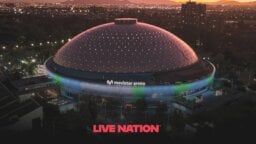In the popular narrative today, Live Nation’s Ticketmaster is a villain, squeezing every last penny out of concertgoers who just want to see a show.
But that narrative is misleading, because – in the view of Live Nation CEO Michael Rapino – it misunderstands what Ticketmaster, and Live Nation more broadly, really are.
“We’re a B2B business,” Rapino said during the company’s 2024 investor presentation, held on Wednesday (November 13).
“We have two B2B [business-to-business] clients, venues for Ticketmaster, and artists for the concert division.”
It might sound strange that Ticketmaster – which sold 144 million tickets to consumers in the first three quarters of this year – would reject the idea that it’s a business-to-consumer business, but Rapino’s reasoning is compelling.
After all, “you don’t go to a Live Nation show, you go to a Coldplay show,” Rapino said.
So what is Live Nation and Ticketmaster’s actual role? In Rapino’s view, in part it’s to absorb the public blowback from the uncomfortable reality that, for the biggest artists, the demand for tickets far outstrips the supply, often leading to millions of frustrated fans.
And, as Live Nation has pointed out repeatedly, Ticketmaster doesn’t set ticket prices – that’s done by the artists and sports teams whose events Ticketmaster is servicing.
“We don’t have a lot of control on the consumer product. I can’t tell you what the price is going to be. I can’t tell you how to put it on sale,” Rapino said. “We work for the artist. We take the punch for the artist. We protect the artist.”
And taken punches it has – from the controversy over the collapse of the ticketing system during the sale of Taylor Swift’s tour, to the high prices of Bruce Springsteen’s tour and the more recent outrage over suddenly spiking ticket prices for Oasis’ reunion tour, Ticketmaster has taken the punch again and again.
“We work for the artist. We take the punch for the artist. We protect the artist.”
Michael Rapino, Live Nation
Consumer frustration has also swept up regulators. In the UK, the Competition and Markets Authority has launched an investigation into Ticketmaster’s dynamic pricing during the Oasis ticket on-sale. Most famously, in the US, the Department of Justice has brought an antitrust suit against the company, seeking to break apart Live Nation and Ticketmaster.
Yet Live Nation’s actual clients – venues and performers – are happy with the company, Rapino said.
“You don’t have artists complaining. You have fans that want cheaper ticket prices, but you don’t have our core customers saying we’re not doing a fabulous job,” Rapino said. “So I’m not overly concerned on the consumer side.”
Here are three other things we learned from Live Nation’s investor day presentation:
1. Dynamic pricing means sometimes ticket prices actually come down
Dynamic pricing – ticket prices shifting in real time, in response to consumer demand – has been one of Live Nation’s most controversial innovations.
Oasis fans took to social media to criticize the company when tickets for the band’s 2025 UK shows tripled in price during the on-sale, causing enough of a brouhaha for regulators to step in, and for Oasis to promise not to use dynamic pricing for its North American shows.
But with dynamic pricing, what goes up can also come down. If the system sees soft demand for certain seats, it will drop the price.
According to Omar Al-joulani, Live Nation’s VP of Touring, “more than 50% of the [price] changes we make is down.”
In other words, contrary to popular belief, dynamic pricing can land you a cheaper ticket at least as often as it might cost you more.
2. 95% of shows don’t sell out, and that means lower ticket prices ahead
Rapino and Al-Joulani mentioned another interesting statistic: Some 95% of Live Nation shows don’t sell out.
This has a few key implications. One is that – contrary to what some consumers believe – Live Nation and Ticketmaster (or, more accurately, the artists who set ticket prices) don’t actually have unlimited pricing power.
If unlimited pricing power exists at all, it exists only for the most popular artists – the Taylor Swifts and Bruce Springsteens, who count their fan base in the tens or even hundreds of millions, and whose shows always sell out.
“There’s a tremendous number of tickets still to sell just in our existing show count, without adding new show count.”
Omar Al-joulani, Live Nation
Another implication is that Live Nation is leaving money on the table in the form of empty seats.
According to Al-Joulani, those 95% of shows that don’t sell out amount to 35 million unsold tickets globally.
“There’s a tremendous number of tickets still to sell just in our existing show count, without adding new show count.”
Live Nation is “just starting to get into that as part of the AOI [adjusted operating income] opportunity,” he says. Going forward, there will be “more optimization of ticket pricing, which generally means reducing price.”
3. Venue Nation has 80 new venues in the pipeline
Buying and/or building live event venues has become a major part of Live Nation’s growth strategy, because – as the company’s leadership has repeatedly emphasized – many of the world’s live music markets are underserved by the sorts of venues needed to hold events.
Live Nation’s solution has been to follow the old Field of Dreams adage: “If you build it, they will come.”
And the adage seems to be true. According to Jordan Zachary, Live Nation’s Chief Strategy Officer, the company’s Venue Nation division has grown into the world’s largest network of theaters and clubs, bringing in $2 billion in revenue annually, including $1 billion from food and beverage sales.
And that’s just for starters. Zachary says Venue Nation’s development team has somewhere in the vicinity of 80 venues in the pipeline, with an expected outlay of around $3.4 billion for acquisitions and new builds. That includes 35 “large venues” targeted to open in the next five years.
“These venues will deliver 20 million annual fans, representing $400 million in AOI across all of our business lines,” Zachary said at the investor day presentation.
Much of that will be outside the US, Live Nation’s home (and largest) market – though not necessarily in the fastest-growing developing markets. Compared to the US, even Western Europe is lacking the kind of venue infrastructure needed to keep the live events business growing, Live Nation says.
“These venues will deliver 20 million annual fans, representing $400 million in AOI across all of our business lines.”
Jordan Zachary, Live Nation
“Our main focus is really arenas, and that global infrastructure, through Western Europe, Asia, Latin America,” Zachary said.
So, given that Live Nation has, in effect, become a real estate company on top of all else, might it make sense to spin off the real estate business into a separate company? Rapino doesn’t think so.
“We’ve looked at that,” he said, but “the cost to spin them out ends up taking most of the margin away from your core.”
In other words, there won’t be any real estate fire sales in Live Nation’s future. The company remains committed to being a live events business.
“It’s our core business,” Rapino said.Music Business Worldwide





